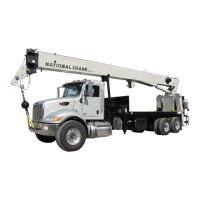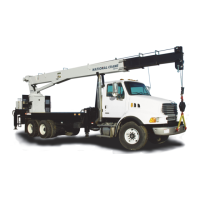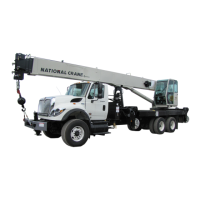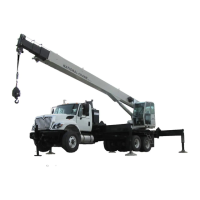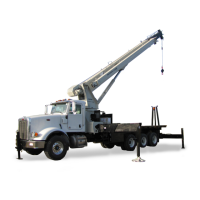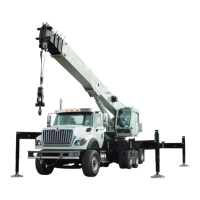National Crane Published 5-27-2018 Control # 039-06 2-7
800D OPERATION
OPERATING PROCEDURES
EQUIPMENT FAMILIARIZATION
All members of the crew should become thoroughly familiar
with the location and operation of controls, the correct
operating procedure, the maximum lifting capacities and the
safety precautions applicable to the unit before operating.
This crane is a complex piece of equipment and can be
overloaded in many ways. Carefully follow the operating
procedures outlined below and in the instructional pages of
the load rating chart at the operator’s station.
EQUIPMENT CHECKS
Perform the following checks prior to placing the unit in
operation:
• Inspect for any unusual conditions such as pools of
hydraulic fluid or lubricating oil under the chassis, any
outrigger which may have crept down or up and any
signs of damage or improper maintenance.
• Check that the tires are inflated to the proper pressure.
• Check the level of the hydraulic reservoir.
• Check the operation of the “stop” and horn circuits.
• Check for missing and loose bolts.
• Check for damaged structural members and welds.
• Check all rope guides and cable keepers.
• Check all sheaves for free turning.
• Check the loadline cable for kinks, broken strands or
other damage in accordance with instructions in the
“Lubrication & Maintenance” section.
• Check to see that the hydraulic hoses and fittings are in
good condition and show no signs of leaking. The hoses
should be free from cuts and abrasions and there should
be no evidence of binding. Any damage or leakage
should be repaired immediately.
• Check optional HCA and anti-two-block system or RCL
and anti-two-block system for proper operation.
Note: Consult truck manufacturer’s manual for vehicle
checks.
Cold Weather Operation
The following recommendations are for operating National
cranes in regions with ambient temperatures below -9°C
(15°F) which are considered arctic.
Cranes should have appropriate hydraulic oil, lubricants, and
other auxiliary items required for operation in very cold
temperatures. Operate individual crane functions to ensure
they are sufficiently warmed prior to performing a lift.
Operation of cranes at full rated capacities in temperatures
between -9°C (15°F) and -40°C (-40°F) or lower should be
accomplished only by competent operators who possess the
skill, experience, and dexterity to ensure smooth operation.
Shock loading shall be avoided.
Operation Below -40°C
For crane operation below -40°C, capacities shall be derated
3.67 percent of the rated load shown on the capacity charts
for each degree below -40°C.
Operation Below -40°F
For crane operation below -40°F, capacities shall be derated
2 percent of the rated load shown on the capacity charts for
each degree below -40°F.
CRANE WARM-UP PROCEDURES
The following procedures detail the actions that must be
taken to properly warm the different crane components
before operating the crane.
NOTE: For temperatures below -9°C (15°F) refer to arctic
lubricants and conditions in the Operator and
Service Manuals.
Before starting the crane, ensure the appropriate lubricants
are used to provide lubrication for the prevailing ambient
temperatures in which the crane will operate in (a list of
lubricants and their temperature ranges can be found in
Lubrication on page 4-1, by contacting your local National
Crane distributor, or by contacting Manitowoc Crane Care
directly).
Engine
NOTE: For National Crane engine warm-up procedures,
refer to chassis manufacturer’s manual.
Warm-up Procedures for All Temperature Ranges:
CAUTION
Crane Damage Hazard!
Operating the crane with the incorrect lubricants and
fluids for the prevailing ambient temperature and/or failing
to adequately warm the crane prior to cold weather
operation can lead to a failure of a crane component or
system.
Always use National Crane recommended lubricants and
fluids for the prevailing ambient temperature and properly
start and warm the crane using the cold weather
procedures found in this Operator Manual before
operating the crane at full load.
Fo
r
Reference
Only
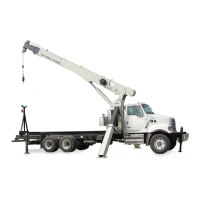
